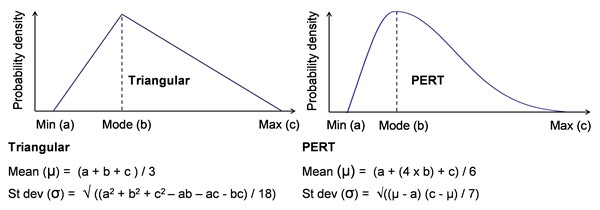Practical Project Risk Management
SERIES ARTICLE
By Martin Hopkinson
United Kingdom
Purpose
Provide a simple means of modelling the magnitude and range of risk impacts or effects.
Three-point estimates are often made for the cost or schedule effects of project risk. However they may also be used in connection with other important variables. For example, on an aircraft development project, design-related risks might be assessed for weight modelling purposes. Three-point estimates are often used as inputs to quantitative risk analysis.
Probability Density Functions
Three-point estimates are used to create probability density functions (PDFs). Two of the most commonly used PDF shapes are the Triangular and the PERT (often called betaPERT).

A triangular distribution has a higher standard deviation than a PERT distribution with the same range. Moreover, whereas the standard deviation of a triangular distribution increases as its shape is skewed (i.e. as the mode comes closer to the Min or Max), the reverse is the case for a PERT distribution.
The triangular distribution’s higher standard deviation may be argued as a reason for using it in preference to PERT as a means of compensating for the tendency for three point estimates to be unrealistically narrow. However, this thinking can lead to lazy estimating. It is more important to ensure that each three-point estimate is unbiased and has a realistic width (see recommended approach below).
Confidence-based Three-point Estimates
An alternative approach uses the optimistic and pessimistic points to represent confidence levels e.g. 10th percentile (P10) and 90th percentile (P90) values. Some estimators are more comfortable with this than estimating extremes…
More…
To read entire article, click here
Editor’s note: This series of articles is by Martin Hopkinson, author of the books “The Project Risk Maturity Model” and “Net Present Value and Risk Modelling for Projects” and contributing author for Association for Project Management (APM) guides such as Directing Change and Sponsoring Change. These articles are based on a set of short risk management guides previously available on his company website, now retired. For an Introduction and context for this series, click here. Learn more about Martin Hopkinson in his author profile below.
How to cite this paper: Hopkinson, M. (2022). Three-point Estimates: A brief guide, Practical Project Risk Management series, PM World Journal, Vol. XI, Issue XI, November. Available online at https://pmworldlibrary.net/wp-content/uploads/2022/10/pmwj123-Nov2022-Hopkinson-three-point-estimates-risk-management-article.pdf
About the Author

Martin Hopkinson
United Kingdom
![]()
Martin Hopkinson, recently retired as the Director of Risk Management Capability Limited in the UK, and has 30 years’ experience as a project manager and project risk management consultant. His experience has been gained across a wide variety of industries and engineering disciplines and includes multibillion-pound projects and programmes. He was the lead author on Tools and Techniques for the Association for Project Management’s (APM) guide to risk management (The PRAM Guide) and led the group that produced the APM guide Prioritising Project Risks.
Martin’s first book, The Project Risk Maturity Model, concerns the risk management process. His contributions to Association for Project Management (APM) guides such as Directing Change and Sponsoring Change reflect his belief in the importance of project governance and business case development.
In his second book Net Present Value and Risk Modelling for Projects he brought these subjects together by showing how NPV and risk modelling techniques can be used to optimise projects and support project approval decisions. To learn more about the book, click here.
To view other works by Martin Hopkinson, visit his author showcase in the PM World Library at https://pmworldlibrary.net/authors/martin-hopkinson/









